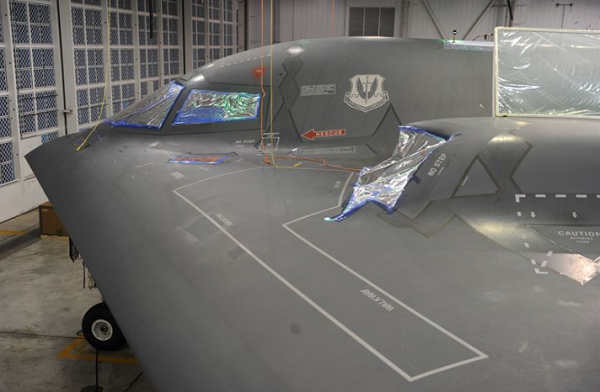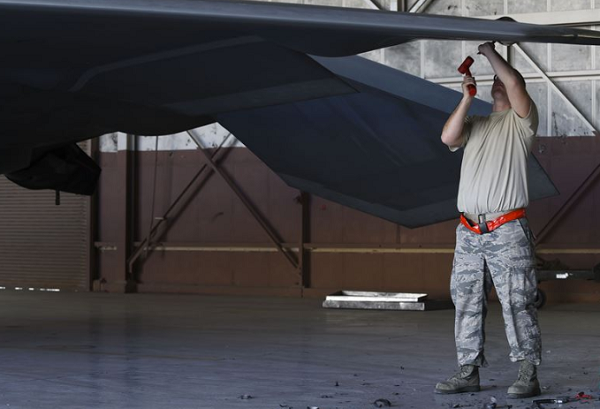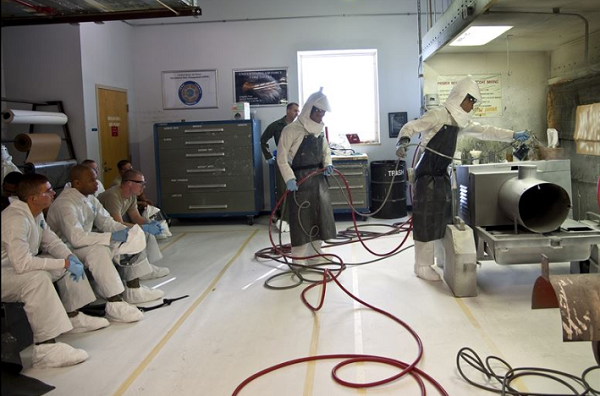Air Force Low Observable Aircraft Structural Maintenance (2A7X5) specialist design, fabricate and modify unique metals and bonded materials for stealth aircraft.
These specialist do everything from initial designs to repairing damage.
They are in charge of making sure the structural integrity of low observable aircraft remain in-tact during all repairs.
Jump To A Section
Education, Qualifications and Training
This job requires individuals to work in potentially high-security areas and on projects that may be top-secret, therefore, there are a few more security checks that individuals must pass prior to being recruited.
Related Article: 41 Questions To Ask A Military Recruiter
Education
The minimum education required for this position is a High School Diploma or GED.
Recruits must take and pass the Air Force Mechanical ASVAB requirements.
Qualifications
Minimum requirements for this position include:
- Knowledge of low observable aircraft construction features
- Complete/Pass: National Agency Check; Local Agency Check and Credit Check
- Be at least 17 with parental consent (18 without) and no older than 39 (learn more about Air Force age limits here)
Training
After passing all background checks, physicals, and medical evaluations, individuals will attend Basic Military Training for 8.5 weeks.
For the Low Observable Aircraft Structural Maintenance position, recruits will attend Technical Training at Pensacola NAS in Florida for 60 days.
What does a Low Observable Aircraft Structural Maintenance Specialist do?

These individuals are in charge of determining the extend of the damage to an aircraft and making a plan to restore and replace parts as needed.
This plan includes making sure that all repairs will keep the strength, weight and contour similar to original design.
Specialist work to repair and remove structural parts and components while preserving the structural integrity of the aircraft as defined by the requirements.
They will manufacture layouts, jigs, fixtures and molds.
Checking corrosion protection treatment need is included in the observation and repair process.
Specialist access the aircraft interior by removing panels, doors and skin fasteners.
They will perform interior maintenance and then replace all fasteners.
These airmen clean the exterior surface and then apply filler treatments, fairing materials, adhesives, sealants, rain erosion or any other top coat that needs to be applied.
There are several different adhesive and chemical types they are using so they must ensure that maintainer-fabricated enclosures, heaters and climate control equipment are used for proper drying and proper ventilation.
In addition to the proper area/environment to work in, airmen will use ambient and accelerated cure processes to cure all of the top coat material.
Radar Absorbent Material (RAM)
Radar Absorbent Material is the material applied to an aircraft to absorb radar waves and reflection, decreasing the probability that the aircraft will be detected.
This is very important for a stealth aircraft in the Air Force.
Specialist remove, repair and install Radar Absorbent Material.
The steps for this process are:
- Remove the RAM by manually pulling, scraping using power methods or by sanding
- Repair the RAM by fabricating parts using cutting tools
- Adhere the RAM to the aircraft using vacuum bags, fixtures and other pressure inducing processes
- Scrim material is applied to the RAM and aircraft
- Cover strips are applied to the panel and gaps
- RAM pastes are applied to cover any gaps, voids or gouges
- The RAM and the paste are sanded and skived
- Low observable treatments (compounds, adhesives, primers, conductive films) are added to polycarbonate transparencies
- Aircraft paint schemes and markings are applied
When the repairs are finished, Low Observable Aircraft Structural Maintenance specialist will inspect the final assembly and ensure it is ready for use.
They inspect all of the repairs and compare the replacements to technical data specifications.
If any necessary corrective actions need to be completed on the repair, they will complete the work.
Specialist inspect, maintain and perform operator maintenance on tools and equipment.
All maintenance activities and inspections will be logged by the Low Observable Aircraft Structural Maintenance specialist.
They will make recommendations on equipment performance improvements and maintenance procedures.
Related Article – Air Force Aerospace & Operational Physiology (4M0X1): Career Details
What does an Air Force Low Observable Aircraft Structural Maintenance Specialist get Paid?
Even though this position requires higher clearance, it is still considered an entry level position.
Your pay would be based on your rank and time of service.
Entering into this position with an education or previous Military experience will allow you to advance in rank.
You can follow the pay table below to see the base salary range.
| Insignia | Pay Grade | Rank | Abbreviation | 2023 Minimum Monthly Pay |
|---|---|---|---|---|
| E-1 +4 months | Airman Basic | AB | $1,917.60 | |
| E-2 | Airman | Amn | $2,149.20 | |
| E-3 | Airman First Class | A1C | $2,259.90 | |
| E-4 | Senior Airman | SrA | $2,503.50 | |
| E-5 | Staff Sergeant | SSgt | $2,730.30 | |
| E-6 | Technical Sergeant | TSgt | $2,980.50 | |
| E-7 | Master Sergeant | MSgt | $3,445.80 | |
| E-8 | Senior Master Sergeant | SMSgt | $4,957.20 | |
| E-9 | Chief Master Sergeant | CMSgt | $6,055.50 | |
| E-9 | Command Chief Master Sergeant | CCM | $6,055.50 | |
| E-9 | Chief Master Sergeant Of The Air Force | CMSAF | $6,055.50 |
Benefits
In addition to your base pay, the Air Force offers many benefits.
If you did enter into the Air Force without a college degree, there are tuition assistance programs and scholarships available to assist with paying for college.
Most individuals pay very little to nothing out of pocket for tuition.
The Air Force also offers low cost/free health care and dental.
They offer paid sick time, vacation (30 days/year) and low cost life insurance.
Airmen are able to retire after 20 years of service with benefits starting day one of retirement, all while paying zero out of pocket towards their plan.
Based on location and family status, housing and food allowances are available.
There are also recreational activities, centers, social activities and youth activities available at each base.
To find more information about Air Force pay structure or the offered benefits, visit their website here.
Related Article – Air Force Radar, Airfield & Weather Systems (1C8X3): Career Profile
Job Reviews

Working in aircraft maintenance in the Air Force is demanding.
It is also very rewarding to know that the work that you are completing makes it so aircraft can go as undetected as possible through the sky.
Reviews of aircraft maintenance positions include both positive aspects and negative aspects.
Positives:
- Great Benefits
- Ability to Travel
- Meaningful work
- Experience that translates to other positions
- Work is different day-to-day
Negatives:
- Long Hours
- Multiple deployments
- Progression may rely on leadership
- Difficulty establishing a work/home life balance
Any position in the Air Force is going to be what you make of it.
If you enter with the general understanding of job functions and that the hours may be demanding, you could find yourself enjoying the position.
Civilian Career Opportunities
The skills learned in Low Observable Aircraft Structural Maintenance will directly relate to maintenance in a civilian position.
You do not have to continue with working in aviation as the experience would relate to other manufacturing jobs as well.
Position duties such as mixing/preparing different adhesives and working with fabricating tools will open doors, too.
There are low observable positions working in public aviation facilities.
Position titles that are relate-able as a civilian include:
- Aircraft Maintenance Technician
- Aircraft Inspector
- Low Observable Coater
- Maintenance Planner
- Performance Engineer
- Low Observable Materials and Processes
- Low Observable Materials Engineer
- Enrollment Tech
Related Article – The Ultimate Guide To Becoming A Private Military Contractor
Summary
Air Force Low Observable Aircraft Structural Maintenance specialist are in charge of inspecting and repairing low observable aircraft parts.
They are the ones responsible for the removal, design, repair, replacement and sealants that make an Air Force Low Observable Aircraft the least radar detectable as possible.
This position follows basic requirements with advanced background checks.
The pay follows the standard pay table for a non-officer position and offers benefits to all individuals.
Individuals in aircraft maintenance like the work that they perform, but do not always love the hours.
Receiving experience in this position will open many doors in civilian careers as the job functions directly relate to low observable aircraft maintenance, general aircraft maintenance and other manufacturing positions.
References:
Air Force Low Observable Aircraft Structural Maintenance
- 5 Worst Jobs in the Air Force - June 20, 2024
- 4 Steps For Visiting An Air Force Recruiter Near You - June 19, 2024
- Air Force Safety Specialist (1S0X1) - June 19, 2024
Originally posted on September 15, 2019 @ 3:17 am
Affiliate Disclosure: This post may contain affiliate links. If you click and purchase, I may receive a small commission at no extra cost to you. I only recommend products I have personally vetted. Learn more.
